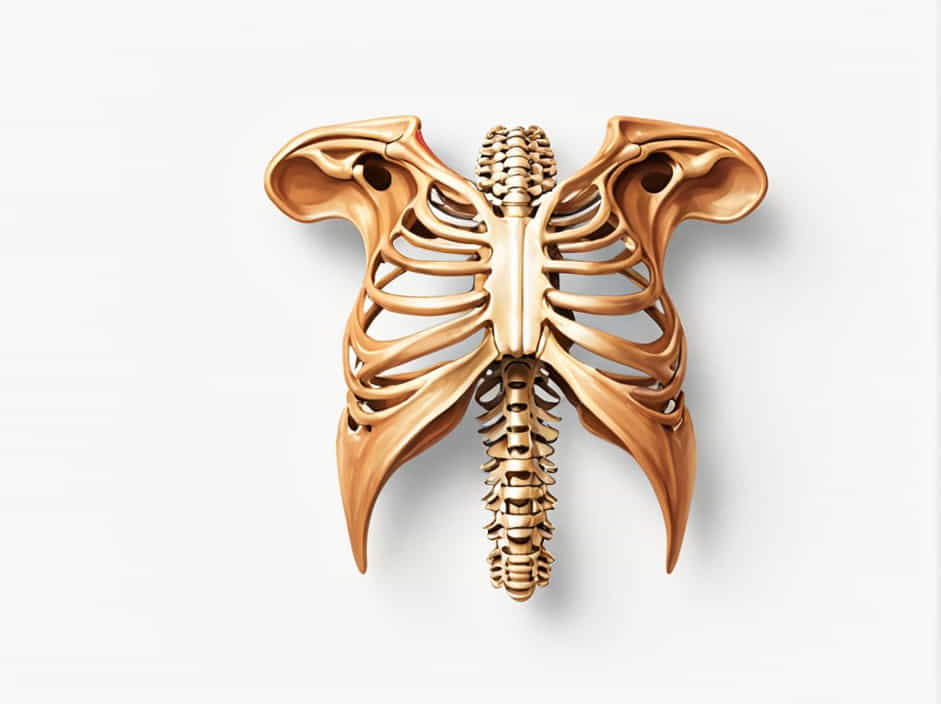The pectoral girdle, also known as the shoulder girdle, is a crucial structure in the human skeleton that connects the upper limbs to the axial skeleton. It consists of two main bones: the clavicle (collarbone) and the scapula (shoulder blade). These bones provide support, stability, and mobility for the arms, enabling a wide range of movements essential for daily activities.
Understanding the anatomy, function, and clinical significance of the pectoral girdle is important for medical students, healthcare professionals, and anyone interested in human anatomy. This topic explores the bones of the pectoral girdle, their functions, and related disorders.
Bones of the Pectoral Girdle
The pectoral girdle consists of two paired bones on each side of the body, forming a strong yet flexible support system for the upper limbs.
1. Clavicle (Collarbone)
The clavicle is an S-shaped bone that connects the sternum (breastbone) to the scapula. It is located at the front of the shoulder and plays a vital role in stabilizing the upper limb.
Key Features of the Clavicle:
- Acts as a brace that holds the shoulders apart.
- Protects underlying nerves and blood vessels in the neck region.
- Serves as an attachment site for muscles of the shoulder and neck.
Functions of the Clavicle:
- Structural Support: Helps maintain shoulder alignment and prevents the arms from collapsing inward.
- Force Transmission: Transfers forces from the arm to the central skeleton, reducing strain on the shoulder joint.
- Muscle Attachment: Provides anchor points for important muscles, such as the pectoralis major and deltoid.
Common Clavicle Injuries:
- Clavicle Fractures: One of the most common fractures in the body, often caused by falls or direct impact.
- Dislocations: The sternoclavicular or acromioclavicular joints can become dislocated due to trauma.
2. Scapula (Shoulder Blade)
The scapula is a flat, triangular bone located on the upper back. It plays a key role in shoulder movement and stability.
Key Features of the Scapula:
- Contains the glenoid cavity, where the humerus (upper arm bone) attaches, forming the shoulder joint.
- Has three major projections:
- Spine of the scapula (bony ridge on the back).
- Acromion process (extends over the shoulder joint).
- Coracoid process (a small hook-like structure for muscle attachment).
Functions of the Scapula:
- Supports Shoulder Movements: Acts as a stable base for muscle attachment, allowing smooth arm movements.
- Enhances Mobility: Works with muscles and joints to enable rotation, elevation, and abduction of the arms.
- Protects Internal Structures: Shields important nerves and blood vessels.
Common Scapular Disorders:
- Scapular Dyskinesis: Improper movement of the scapula, often caused by muscle imbalances or injuries.
- Winged Scapula: A condition where the scapula sticks out abnormally, usually due to nerve damage.
Joints of the Pectoral Girdle
The pectoral girdle connects to the axial skeleton and the upper limbs through three primary joints:
1. Sternoclavicular Joint (SC Joint)
- Connects the clavicle to the sternum.
- Allows slight movement to accommodate shoulder and arm motion.
- Strengthened by ligaments and cartilage.
2. Acromioclavicular Joint (AC Joint)
- Located where the clavicle meets the acromion process of the scapula.
- Helps in shoulder movements and provides stability.
- Can be injured due to falls or direct trauma (commonly called a “separated shoulder”).
3. Glenohumeral Joint (Shoulder Joint)
- The ball-and-socket joint between the scapula and humerus.
- Allows a wide range of motion, including flexion, extension, rotation, and abduction.
- Stabilized by the rotator cuff muscles and ligaments.
Muscles Associated with the Pectoral Girdle
The pectoral girdle serves as an attachment point for several muscles that aid in movement and stabilization.
Major Muscles Involved:
- Trapezius: Controls scapular elevation, retraction, and rotation.
- Deltoid: Responsible for arm abduction.
- Pectoralis Major & Minor: Help with arm flexion, adduction, and internal rotation.
- Serratus Anterior: Prevents scapular winging and assists in arm movements.
Functions of the Pectoral Girdle
1. Upper Limb Mobility
- The pectoral girdle allows free movement of the arms, enabling activities like lifting, throwing, and pushing.
2. Strength and Stability
- Provides a strong base for the upper limbs while maintaining flexibility and mobility.
3. Protection of Vital Structures
- Shields important nerves, arteries, and the upper ribcage from injury.
Common Disorders of the Pectoral Girdle
1. Shoulder Impingement Syndrome
- Occurs when the tendons of the rotator cuff are compressed, leading to pain and limited movement.
2. Frozen Shoulder (Adhesive Capsulitis)
- A condition where the shoulder joint becomes stiff and painful, often due to inflammation or injury.
3. Fractures and Dislocations
- Clavicle fractures and shoulder dislocations are common in sports and accidents.
4. Rotator Cuff Tears
- Damage to the muscles and tendons around the shoulder joint, often caused by overuse or aging.
How to Maintain a Healthy Pectoral Girdle
1. Strengthen Shoulder Muscles
- Engage in exercises like shoulder presses, push-ups, and resistance training to keep muscles strong.
2. Maintain Good Posture
- Avoid slouching to prevent stress on the clavicle and scapula.
3. Prevent Overuse Injuries
- Avoid repetitive shoulder movements without proper warm-ups and stretching.
4. Seek Medical Attention for Pain
- Early diagnosis and treatment of shoulder pain can prevent long-term damage.
The pectoral girdle, composed of the clavicle and scapula, is essential for upper limb movement, support, and stability. It connects the arms to the axial skeleton, allowing for a wide range of motion and playing a key role in daily activities.
By understanding the anatomy, function, and common disorders of the pectoral girdle, individuals can take steps to maintain shoulder health and prevent injuries. Proper exercise, posture, and medical care are crucial for keeping this vital skeletal structure in optimal condition.
